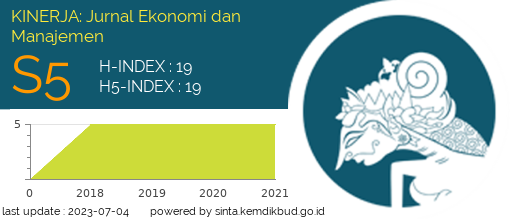Pengaruh kualitas lingkungan fisik dan kualitas layanan terhadap kepuasan pengunjung dan pesan berantai
Abstract
Makanan tradisional menjadi salah satu daya tarik pengunjung untuk datang ke suatu destinasi wisata kuliner. Penelitian ini bertujuan mengeksplorasi pengaruh kualitas lingkungan fisik dan kualitas layanan terhadap kepuasan pengunjung dan pesan berantai pada rumah makan tradisional. Sampel penelitian adalah konsumen yang datang dan menikmati makanan yang disajikan oleh rumah makan tradisional di Kota Palembang sebanyak 200 responden dengan menggunakan teknik convenience sampling. Analisis data menggunakan Model Persamaan Struktural (SEM) dengan bantuan AMOS 22.00. Hasil penelitian menjelaskan bahwa kualitas lingkungan fisik berpengaruh tidak signifikan terhadap kepuasan pengunjung. Kualitas lingkungan fisik berpengaruh tidak signifikan terhadap pesan berantai. Kualitas makanan berpengaruh signifikan terhadap kepuasan pengunjung. Kualitas makanan berpengaruh tidak signifikan terhadap pesan berantai. Kepuasan pengunjung berpengaruh signifikan terhadap pesan berantai. Hasil penelitian ini dapat menjadi masukan bagi pengelola rumah makan dalam memberikan pelayanan lebih baik kepada pengunjung.
Keywords
Full Text:
PDF (Bahasa Indonesia)References
Anwar, S. &, & Gulzar, A. (2011). Impact of perceived value on word of mouth endorsement and customer satisfaction: mediating role of repurchase intentions. International Journal of Economics and Management Sciences, 1(5), 46–54.
Chen, Hung, Lung; Chen, Mei-Yen; Ye, Yun-Ci; Tung, Wu, I; Cheng, Fu, Chih & Tung, S. (2012). Perceived service quality and life satisfaction: the mediating role of the actor ’ s. International Journal of Sports Marketing and Sponsorship, 13(4), 7–24.
Chiou, H. (2003), Social and Behavioral Science Quantification Research and Statistical Analysis, 2nd ed., Wu‐Nan Press, Taipei.
Eriksson, K. &, & Vaghult, Anna, L. (2000). Customer Retention, Purchasing Behavior and Relationship Substance in Professional Services. Industrial Marketing Management, 29, 363–372.
Garbarino, E. &, & Johnson, M. S. (1999). The Trust , Different Roles of Satisfaction , Commitment in Customer and. Journal of Marketing, 63(2), 70–87.
Geyskens, Inge & Steenkamp, E. M. J.-B. (2000). Economic and Social Satisfaction : Measurement and Relevance to Marketing Channel Relationships. Journal of Retailing, 76(1), 11–32.
Ha, J., & Jang, S. S. (2010). Effects of service quality and food quality : The moderating role of atmospherics in an ethnic restaurant segment. International Journal of Hospitality Management, 29(3), 520–529. https://doi.org/10.1016/j.ijhm.2009.12.005
Ha, J., & Jang, S. S. (2012). The effects of dining atmospherics on behavioral intentions through quality perception. Journal of Services Marketing, 26(3), 204–215. https://doi.org/ 10.1108/ 08876041211224004
Hair, F. J., Black, C. W., Babin, J. B., & Anderson, E. R. (2009). Multivariate Data Analysis (Seventh Ed). New York: Prentice Hall.
Jalilvand, Reza, M., Ebrahimi, A., & Samiei, N. (2013). Toward Islamic Destinations and Travel Intention : an Empirical Study in. Procedia - Social and Behavioral Sciences, 81(2006), 484–489. https://doi.org/10.1016/j.sbspro.2013.06.465
Jalilvand, Reza, M., & Samiei, N. (2012). The effect of word of mouth on inbound tourists’ decision for traveling to Islamic destinations (the case of Isfahan as a tourist destination in Iran). Journal of Islamic Marketing, 3(1), 12–21.
Jalilvand, Reza, M., & Samiei, N. (2012). The impact of electronic word of mouth on a tourism destination choice. Internet Research, 22(5), 591–612. https://doi.org/10.1108/ 10662241211271563
Jalilvand, R. M., Salimipour, S., Elyasi, M., & Mohammadi, M. (2017). Factors influencing word of mouth behaviour in the restaurant industry. Marketing Intelligence & Planning, 35(1), 81–110. https://doi.org/10.1108/MIP-02-2016-0024
Jeong, E., & Jang, S. (2011). Restaurant experiences triggering positive electronic word-of-mouth (eWOM) motivations. International Journal of Hospitality Management, 30(2), 356–366. https://doi.org/10.1016/j.ijhm.2010.08.005
Kline, R.B. (2005), Principles and Practice of Structural Equation Modeling, The Guilford Press, New York, NY.
Liu, Y., & Jang, S. S. (2009). Perceptions of Chinese restaurants in the U . S .: What affects customer satisfaction and behavioral intentions ? International Journal of Hospitality Management, 28(3), 338–348. https://doi.org/10.1016/j.ijhm.2008.10.008
Longart, P. (2010). What drives word-of-mouth in restaurants ? International Journal of Contemporary Hospitality Management, 22(1), 121–128. https://doi.org/10.1108/ 09596111011013516
Mattila, S, A. (1998). Emotional Bonding and Restaurant Loyalty. Cornell Hotel and Restaurant Administration Quarterly, 39(1), 12–25.
Payne, A., & Frow, P. (2005). A Strategic Framework for Customer Relationship Management. Journal of Marketing, 69, 167–176.
Peri, C. (2006). The universe of food quality. Food Quality and Preference, 17, 3–8. https://doi.org/ 10.1016/j.foodqual.2005.03.002
Ryu, Kisang & Han, H. (2009). Influence of the Quality of Food, Service, and Physical Environment on Customer Satisfaction and Behavioral Intention in Quick-Casual Restaurants: Moderating Role of Perceived Price. Journal of Hospitality & Tourism Research, 34(3), 310–329. https://doi.org/10.1177/1096348009350624
Sulek, J. M., & Hensley, R. L. (2004). The Relative Importance of Food , Atmosphere , and Fairness of Wait The Case of a Full-service Restaurant. Cornell Hotel and Restaurant Administration Quarterly, 45(3), 235–247. https://doi.org/10.1177/0010880404265345
Susskind, M, Alex & Chan, E. K. (2000). How Restaurant Features Affiict Check Averages. Cornell Hotel and Restaurant Administration Quarterly, 56–63.
Teng, C., & Chang, J. (2013). Mechanism of customer value in restaurant consumption : Employee hospitality and entertainment cues as boundary conditions. International Journal of Hospitality Management, 32, 169–178. https://doi.org/10.1016/j.ijhm.2012.05.008
Wirstz, Kochen; Chew, P. (2002). The effects of incentives , deal proneness , satisfaction and tie strength on word-of-mouth behaviour. International Journal of Service and Insutri Manegement, 13(2), 141–162. https://doi.org/10.1108/09564230210425340
Yuksel, Atila; Yuksel, F. (2002). Measurement of tourist satisfaction with restaurant services : A segment-based approach. Journal of Vacation Marketing, 9(1), 52–68.
DOI: https://doi.org/10.30872/jkin.v16i2.6184
Refbacks
- There are currently no refbacks.
Copyright (c) 2019 Jusmawi Bustan, Heri Setiawan
Kinerja: Jurnal Ekonomi dan Manajemen
Faculty of Economics and Business, Mulawarman University
Jl. Tanah Grogot No.1 Samarinda Kalimantan Timur 75119
Email: jkin.feb.unmul@gmail.com
StatCounter: Kinerja


